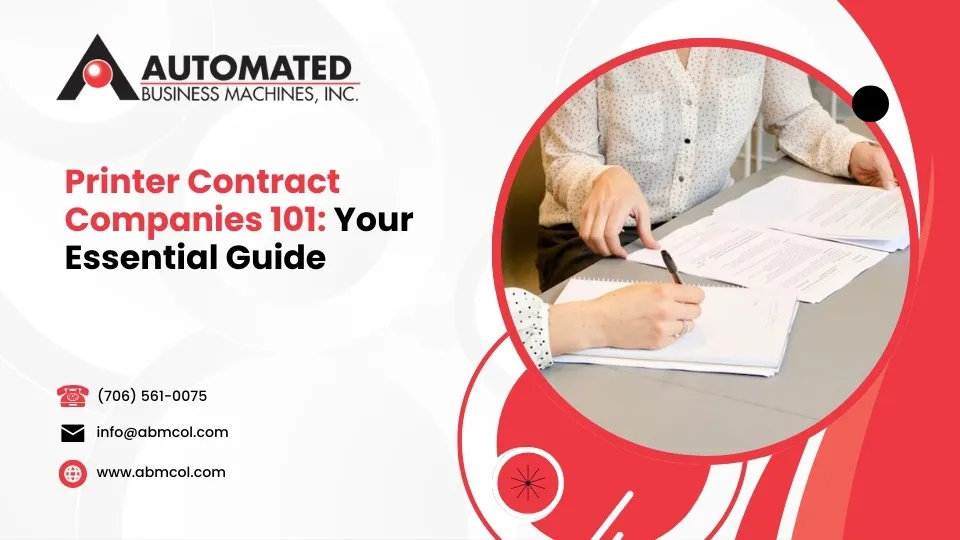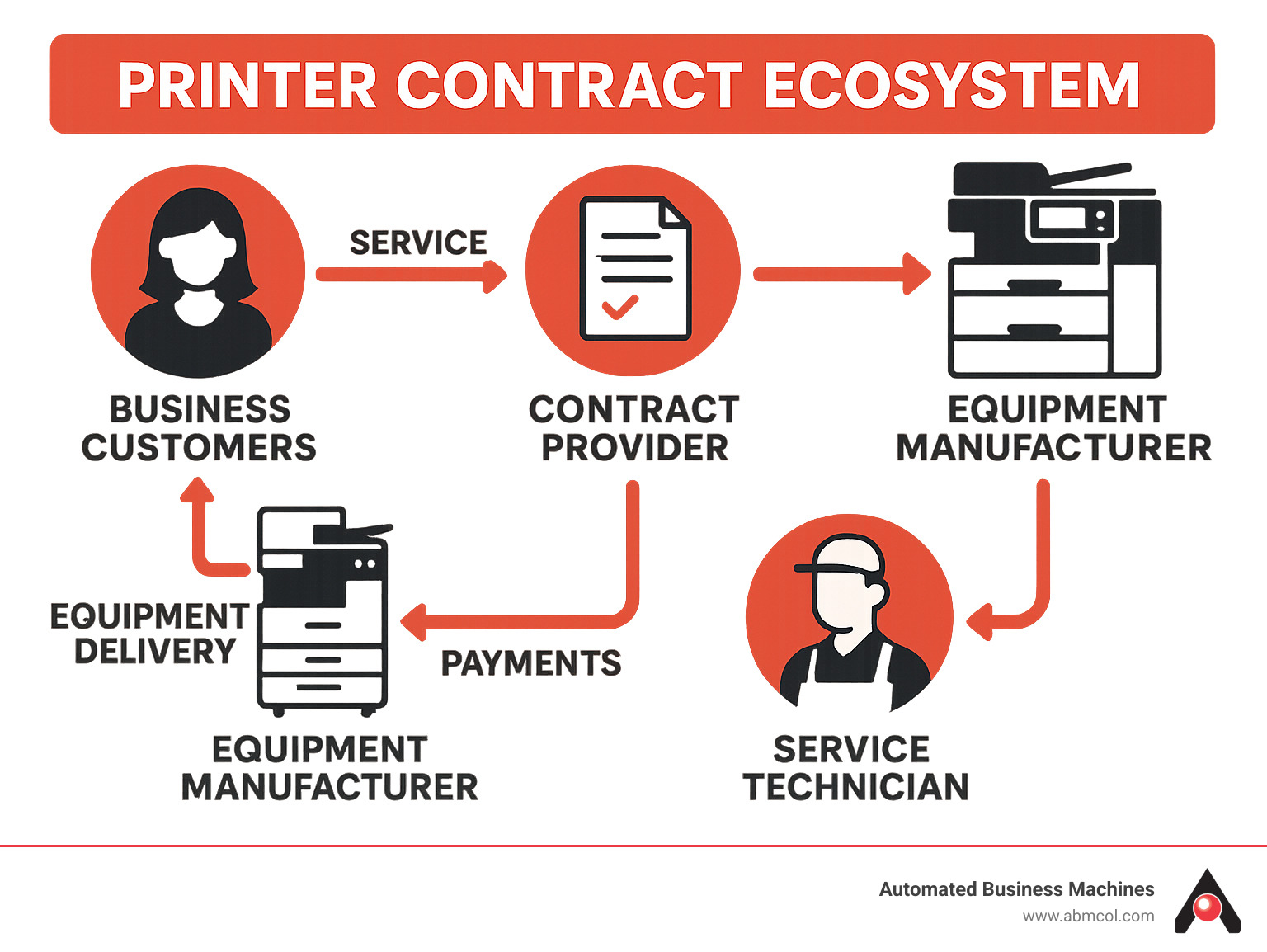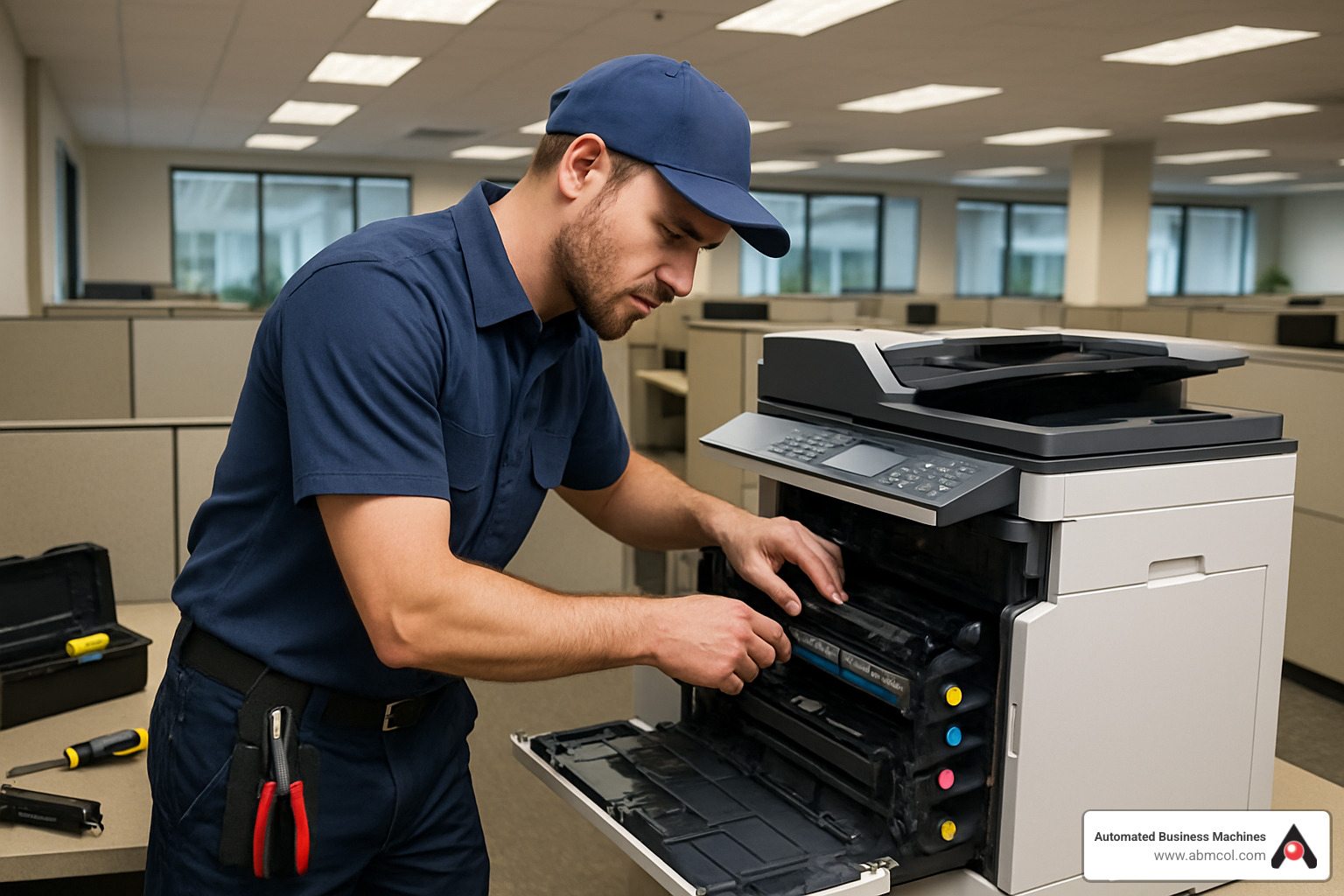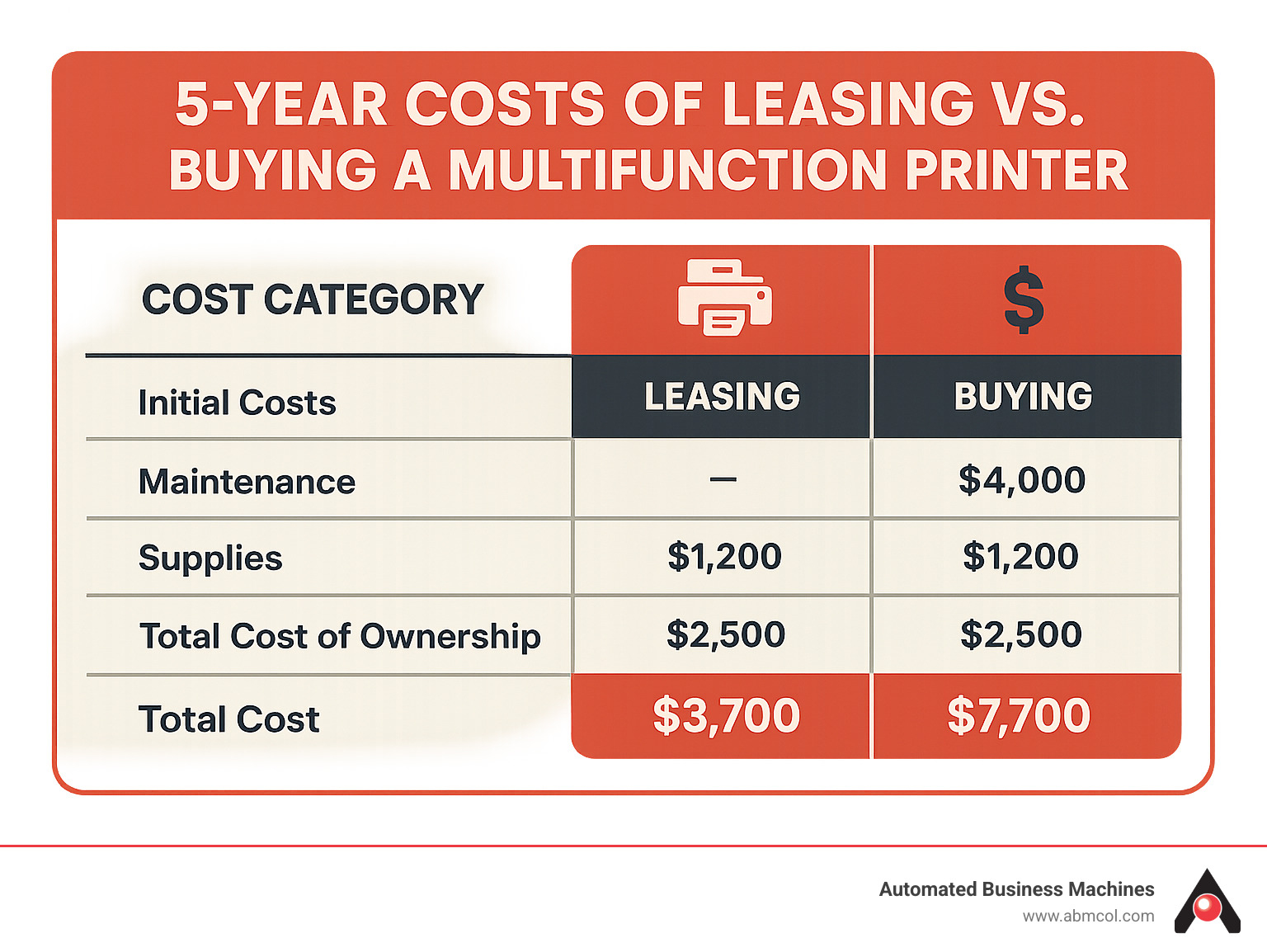
Ever wondered how companies manage their printing needs without breaking the bank? This is where printer contract companies come into play. These specialized providers offer smart alternatives to the traditional “buy and own” approach that can drain your capital budget.
Think of printer contract companies as your printing partners. They create flexible pathways to access high-quality office printing equipment without the hefty upfront investment that purchasing outright requires.
“Over 60% of businesses choose to lease their office printers and copiers rather than buy, citing flexibility and access to the latest technology as key reasons.”
When you work with a printer contract company, you’ll typically encounter several options custom to different business needs. Leasing arrangements provide fixed monthly payments over 24-60 months, often with maintenance bundled in for peace of mind. If you want comprehensive coverage, Managed Print Services (MPS) delivers all-inclusive contracts covering everything from equipment and supplies to maintenance and monitoring.
Need something more temporary? Rental agreements offer shorter terms with easier upgrade paths when your needs change. Some businesses prefer cost-per-page models that tie your expenses directly to actual usage rather than equipment value—perfect for fluctuating print volumes.
Working with printer contract companies transforms how your business handles document production. You’ll immediately notice lower upfront costs, often reducing initial expenditure by up to 80%. Your accounting department will appreciate the predictable monthly expenses that convert unpredictable capital costs into stable operational expenses.
Your IT team will thank you too. With simplified maintenance included in most contracts, you can reduce downtime by up to 50%. No more emergency runs to the office supply store either—automatic supply replenishment ensures you never run out of toner or ink at critical moments. As technology evolves, you’ll benefit from regular equipment updates that keep your capabilities current without additional investments.
Mid-sized companies find these arrangements particularly valuable. You can deploy enterprise-grade equipment with advanced security features while preserving capital for core business investments. The service guarantees typically included minimize IT burden and prevent workflow disruptions when issues arise.
For tech-savvy office managers, modern printer contracts offer another bonus: seamless integration with existing systems and valuable analytics that reveal print usage patterns across departments. This visibility helps identify opportunities for additional cost savings and workflow improvements.
Understanding Printer Contract Companies
Thinking about getting new printers for your office? Let’s talk about the difference between leasing and buying. Printer contract companies specialize in helping businesses access quality printing equipment without the hefty upfront investment of purchasing.
The main difference is really about who owns what. When you buy a printer outright, it’s yours from day one—along with all the headaches of maintenance, repairs, and eventually replacing it when it becomes outdated. When you lease through a printer contract company, you’re simply paying to use the equipment while someone else handles most of the maintenance headaches.
Managed Print Services (MPS) take this convenience even further. They bundle everything together—the equipment, toner, maintenance, and monitoring—into one neat package. It’s pretty impressive that businesses using these services typically save about 23% on their total printing costs!
Your vendor becomes more than just a supplier; they become a partner in managing your entire document environment. They’ll handle everything from setting up your equipment to scheduling maintenance, fixing problems, managing supplies, and even properly disposing of old equipment when it’s time for an upgrade. This frees up your IT team to focus on more important projects.
Service-level agreements (SLAs) are the backbone of these relationships. They clearly spell out response times, uptime guarantees, and support details. These agreements effectively transfer a significant amount of operational risk from your shoulders to the printer contract company.
The tax benefits are another nice bonus. Since lease payments are generally considered operational expenses rather than capital expenditures, they’re fully tax-deductible in the year you make them. This typically creates tax savings of 10-20% for small businesses compared to buying outright.
How Printer Contract Companies Work
Working with a printer contract company follows a pretty straightforward process:
First, they’ll assess your current printing setup and needs. Then they’ll recommend the right equipment and service package for your situation. Once you’ve agreed, they’ll implement everything by installing and configuring your new devices. From there, they manage everything—monitoring usage, performing maintenance, and delivering supplies when needed. When your contract term ends, you’ll have options for renewal, upgrading, or returning the equipment.
Throughout your contract, the printer contract company maintains ownership of the hardware, though some leases do include an ownership transfer when the term ends.
At the end of your contract, you typically have several choices: return the equipment, upgrade to newer models with a fresh contract, buy the equipment at fair market value, or extend your lease at a reduced rate.
Most quality providers include uptime guarantees in their agreements. At Automated Business Machines, we stand behind our service with guaranteed response times and resolution windows to minimize any disruption to your business.
Types of Agreements Offered by Printer Contract Companies
Printer contract companies offer several agreement types to fit different business needs:
Operating Lease is the most popular option, running 2-5 years with fixed monthly payments. The equipment remains the leasing company’s asset, and you can upgrade when your term ends. This is perfect if you like having the latest technology.
Capital Lease (Lease-to-Own) works more like financing a purchase. You’ll pay a bit more each month, but you’ll own the equipment when the lease ends, usually for just a nominal fee.
Rental Agreements cost more per month but offer greater flexibility for shorter terms. They’re ideal for temporary needs, specific projects, or when you want to test equipment before making a longer commitment.
Managed Print Services (MPS) Bundles provide comprehensive coverage including equipment, supplies, maintenance, and monitoring under one contract. These often use cost-per-page pricing instead of fixed monthly payments.
Month-to-Month Agreements offer maximum flexibility without long-term commitments. As many experts note, these arrangements allow businesses to easily scale up or down as their needs change.
Each of these options has its place depending on your specific business needs, cash flow situation, and how you prefer to handle technology updates. The beauty of working with a local provider like Automated Business Machines is that we can help you steer these choices to find the perfect fit for your organization.
Benefits of Leasing vs. Buying Printers
When you’re weighing your options for office printing equipment, working with printer contract companies offers compelling advantages that go beyond the initial price tag. Let’s look at why so many businesses choose leasing over buying:
The cash flow advantage is immediate and significant. Instead of writing a large check upfront, leasing preserves your working capital for revenue-generating activities. Most businesses see upfront costs reduced by up to 80% compared to purchasing, keeping your cash reserves healthy for other priorities.
Technology moves quickly, and yesterday’s cutting-edge printer becomes today’s outdated model faster than you might expect. With a lease, you’re not stuck with obsolete equipment. Most lease terms align perfectly with the typical 3-5 year lifecycle of business printers, ensuring you can upgrade to newer models with better features when your contract ends.
One of the most appreciated benefits is the inclusion of maintenance in most lease agreements. This eliminates those unexpected repair costs that can wreak havoc on tight budgets. The predictability makes financial planning easier, and you’ll spend less time managing service vendors or troubleshooting printer problems.
Downtime drops dramatically when you lease. With priority service and included maintenance, businesses typically experience up to 50% less printer downtime compared to self-managed equipment. As one of our IT manager clients told us, “Before our contract with Automated Business Machines, printer issues consumed several hours of IT time weekly. Now they’re handled promptly by specialists.”
Scalability becomes simple with a lease arrangement. As your business grows or changes direction, you can modify your equipment mix more easily than if you owned your printers outright. Adding equipment mid-lease or upgrading to higher-capacity models becomes a straightforward contract adjustment rather than a new capital expenditure.
There’s also an environmental upside to leasing. Printer contract companies typically have established recycling and refurbishment programs for end-of-life equipment. This responsible disposal reduces your environmental footprint and simplifies compliance with electronic waste regulations.
For a deeper dive into these advantages, check out our Business Printer Leasing Benefits resource.
Financial & Tax Advantages
The financial benefits of working with printer contract companies go well beyond basic cash flow improvements:
Lease payments typically count as operational expenses rather than capital expenditures. This accounting treatment can improve the financial ratios that lenders and investors watch closely when evaluating your business.
In certain lease structures, you might still qualify for Section 179 tax deductions, allowing your business to deduct the full purchase price of qualifying equipment. It’s worth consulting your tax professional to determine if this applies to your situation.
Budgeting becomes more predictable with fixed monthly payments that eliminate the uncertainty of repair costs and supply purchases. As one finance director we work with noted, “Our printer lease converted an unpredictable expense into a consistent monthly line item, making departmental budgeting much more accurate.”
Many operating leases don’t appear as debt on your balance sheet, potentially improving your debt-to-equity ratio and overall borrowing capacity. This off-balance-sheet financing can be particularly valuable for growing businesses.
You also gain a measure of inflation protection by locking in today’s rates for equipment you’ll use over several years, providing a hedge against future price increases.
Productivity & IT Relief Gains
The productivity improvements from working with printer contract companies can be just as valuable as the financial benefits:
Automated toner replenishment means you’ll never face that frustrating moment when an important document won’t print because someone forgot to order supplies. Many managed print contracts include automatic supply monitoring and delivery before you run out.
Remote monitoring capabilities allow service providers to detect and resolve many issues before they impact your operations. Studies show this proactive approach reduces printer-related help desk calls by up to 25%, freeing your IT team for more strategic work.
Professional assessment often reveals opportunities to replace multiple single-function devices with fewer, more efficient multifunction printers. This device consolidation reduces energy consumption, space requirements, and management complexity.
The reduced IT burden might be the most significant hidden benefit. Up to 70% of companies don’t accurately track their total printing costs, and printer management consumes valuable IT resources. Managed print contracts free your technical staff to focus on strategic initiatives rather than printer troubleshooting.
For more insights on how leasing improves workplace efficiency, visit our guide on How Office Copier Leasing Improves Productivity.
Contract Options & Cost Structures
When you’re looking at working with printer contract companies, you’ll find they offer several different ways to structure your payments. Understanding these options helps you make a smart choice that fits your budget and printing needs.
Most printer contracts fall into one of these payment structures:
With a Fixed Monthly Payment, you’ll pay the same amount every month no matter how much you print. It’s like a subscription – super predictable for budgeting, but might not be the best value if your printing needs fluctuate a lot.
The Cost-Per-Page model charges you based on what you actually print. You’ll typically see different rates for black-and-white versus color pages. This approach aligns your costs directly with your usage, and usually includes all supplies except paper. Many of our clients find this the most fair approach.
Some contracts use Volume Bands with tiered pricing. Think of it like a cell phone plan – you might pay one rate for your first 5,000 pages each month, then a lower rate for additional pages. This rewards higher volume with better rates.
With a Base + Overage structure, you’ll have a fixed monthly charge that includes a certain number of pages. Go over that amount, and you’ll pay additional charges for the extra pages. This works well if your printing volume is fairly consistent.
Good comprehensive contracts typically bundle together several elements: the equipment itself, regular maintenance, repair service including parts, toner and supplies (though usually not paper), remote monitoring of your equipment, and help desk support when issues arise.
Just be aware that most contracts include termination fees if you need to exit early. These fees usually decrease over the life of the contract, since they’re designed to help the printer contract company recover their initial investment in your equipment and setup.
Factors That Influence Total Cost
Several key factors can significantly impact what you’ll actually pay over the life of your contract:
Print Volume is the biggest cost driver. The number of pages you print each month directly affects your costs, which is why an accurate assessment of your needs is so important when setting up your contract.
The Color Ratio in your printing makes a huge difference too. Color prints typically cost 5-10 times more than black-and-white pages. One client of ours saved over $300 monthly just by setting their default printing to black-and-white!
Contract Length affects your monthly rate – longer contracts generally offer lower monthly payments but less flexibility. Most businesses find that 36-60 month terms hit the sweet spot, balancing good rates with reasonable technology refresh cycles.
Your chosen Service Response Time can impact costs too. If your business grinds to a halt when printers are down, paying a bit more for faster guaranteed response times might be worth every penny.
The Device Types and Features you select naturally affect pricing. Those convenient finishing options like stapling and booklet making are helpful but add to your equipment costs and lease payments.
Don’t forget to consider End-of-Term Options – contracts with more favorable conditions when the lease ends might carry slightly higher monthly costs.
If your business has multiple locations, Geographic Coverage becomes important. At Automated Business Machines, we provide consistent service across all our Georgia locations, including Atlanta, Augusta, Columbus, and Savannah, making us a great partner for businesses with multiple offices.
Negotiating Better Terms with Printer Contract Companies
With a little preparation, you can secure better terms when working with printer contract companies. Here are some practical strategies:
Benchmark Multiple Quotes by getting proposals from at least three companies. This gives you leverage and helps you understand what’s competitive in the current market.
Take time to Identify Hidden Fees by carefully reviewing contracts. Look for delivery charges, training fees, minimum volume commitments, annual rate increases, and end-of-contract conditions that might cost you extra.
Smart businesses always Negotiate Upgrade Clauses to secure the right to upgrade equipment mid-contract if their needs change. As one of our clients says, “The flexibility to upgrade when we expanded our marketing department saved us from being stuck with inadequate equipment.”
Even if you plan to keep your contract for its full term, Clarify Early-Exit Options. Business circumstances change, and reasonable termination provisions provide insurance against unforeseen developments.
Consider Separating Service from Equipment in your negotiations. This gives you the flexibility to change service providers if performance disappoints, without affecting your equipment lease.
If your contract includes annual rate adjustments, Cap Annual Increases by negotiating maximum percentage limits. This protects your budget against significant jumps in cost.
Always Define “Maintenance” Precisely in your contract. Make sure it clearly states what’s considered regular maintenance versus what would be a billable service call.
For more detailed guidance on getting the best terms possible, check out our resource on Your Guide to Navigating Printer Lease Agreements.
Choosing & Managing Your Printer Contract Partner
Picking the right printer contract company isn’t just about getting a good deal—it’s about finding a partner who’ll support your business for years to come. After all, this relationship will impact everything from your daily operations to your bottom line.
When searching for the perfect partner, start with a thorough vetting process. Look for companies with solid experience in your specific industry. At Automated Business Machines, we’ve worked with businesses across Georgia for years, giving us insight into the unique challenges different sectors face.
Support quality should be at the top of your checklist. Ask potential providers: Do they have their own technicians or outsource to third parties? What are their typical response times? The difference between waiting hours versus days for repairs can dramatically impact your productivity.
The best partners offer flexibility rather than rigid, one-size-fits-all packages. Your business will evolve, and your printing needs will change alongside it. A good provider adapts their offerings to match your growing requirements.
Security can’t be overlooked in today’s connected office environment. Modern printers store sensitive data and connect directly to your network. Make sure your chosen printer contract company understands security best practices and compliance requirements for your industry.
Local coverage matters more than you might think. When a printer breaks down, having a technician nearby means faster resolution. Our coverage across Georgia—including Albany, Athens, Atlanta, and other major cities—ensures our clients never wait long for help when they need it.
Don’t forget to check the company’s financial stability. The last thing you want is your provider going out of business halfway through your contract term. Look for established companies with strong customer retention rates—it’s often a reliable indicator of their stability and service quality.
Strong manufacturer relationships are another good sign. Companies with solid connections to major manufacturers like HP, Canon, or Xerox typically have better access to parts, training resources, and support systems.
Key Checklist When Evaluating Printer Contract Companies
When comparing potential partners, use this checklist to make sure you’re covering all bases:
First, examine their SLA metrics. What specific response times do they guarantee? How do they measure and report on these promises? Good providers are transparent about their performance standards.
Next, understand their supply logistics. How will toner and other consumables be ordered and delivered? Is automated replenishment available to prevent you from running out at critical moments?
Consider scalability carefully. Can the provider easily accommodate your growth? What’s their process for adding equipment mid-contract if your needs expand?
Always request and contact client references, preferably from businesses similar to yours in size and industry. Hearing from current customers provides insights no sales presentation can match.
Look for contract transparency. Are all costs clearly documented, or are there hidden fees lurking in the fine print? The best providers have nothing to hide.
Make sure their offerings provide technology alignment with your existing systems. The right equipment should integrate seamlessly with your current workflows and software.
Ask about their environmental programs for handling supplies and end-of-life equipment. Responsible disposal practices aren’t just good for the planet—they can help your company meet sustainability goals too.
Finally, check what training provisions are included. Will they train your team initially? Is ongoing training available as staff changes occur?
For more guidance on selecting the perfect lease partner, check out our resource on Best Copier Lease for Your Business.
Common Problems and Solutions
Even with careful selection, challenges can pop up during your contract term. Here’s how to handle some common issues:
Excess overage fees can sneak up on you if your print volumes consistently exceed your contract allocation. If this happens, request a contract review and potential restructuring to better match your actual usage patterns. At Automated Business Machines, we proactively monitor usage and suggest adjustments before those fees pile up.
When facing slow repairs, document service delays and follow your contract’s escalation process. Don’t hesitate to request loaner equipment for extended outages—most quality providers will accommodate this request to minimize your downtime.
Technology needs change rapidly, potentially making your leased equipment feel outdated before the contract ends. If this happens, review your upgrade options. Many contracts allow for equipment exchanges with term extensions or minor payment adjustments.
Supply quality issues can plague your productivity when providers cut corners. The simple solution? Specify OEM (Original Equipment Manufacturer) supplies in your contract from the start to ensure optimal performance and reliability.
Billing disputes are common with complex contracts. Protect yourself by maintaining detailed records of your agreement terms and usage patterns. Schedule regular billing reviews with your account manager to catch and address discrepancies early.
If problems persist despite your best efforts, follow your provider’s established escalation path. Document all communications and specifically reference contract terms in your discussions. Most reputable printer contract companies value long-term relationships and will work hard to resolve legitimate concerns.
For more practical advice on managing your printer lease effectively, take a look at our guide on Affordable Copier Leasing Tips.
Frequently Asked Questions about Printer Contract Companies
Thinking about working with a printer contract company but not sure what to expect? You’re not alone. Here are answers to the questions we hear most often from businesses considering printer leases:
What are typical printer lease terms?
Most businesses choose lease terms between 24 and 60 months, with 36 or 48 months being the sweet spot for many. Shorter terms give you more flexibility to upgrade sooner, but you’ll pay more each month. Longer terms spread the cost out further, reducing monthly payments, but might keep you using the same equipment longer than ideal.
Watch out for those sneaky automatic renewal clauses! Many contracts will automatically renew if you don’t cancel within a specific window – usually 90-180 days before the lease ends.
One office manager learned this lesson the hard way: “We missed our cancellation window by two weeks and were automatically renewed for another year. Now we calendar reminders six months before any contract expires.”
Don’t forget about annual rate increases either. Most contracts include yearly bumps of 1-3%, which add up over time. Make sure to factor these into your budget projections.
How are maintenance and supplies handled?
You’ll typically see two approaches to maintenance and supplies:
With bundled agreements, everything except paper is included in your monthly payment or cost-per-page rate. This keeps things simple – one payment covers equipment, service, parts, and supplies. No surprise bills when something breaks down.
Some businesses prefer separate agreements, keeping equipment leases distinct from maintenance and supplies. While this gives you the freedom to change service providers if you’re unhappy, it adds complexity to your billing and management.
Your Service Level Agreement (SLA) will spell out exactly how quickly you can expect help when problems arise. Most agreements promise:
- Phone support within 1-2 hours
- On-site technician within 4-8 business hours
- Parts delivery within 1-2 business days
At Automated Business Machines, we keep extensive parts inventories across Georgia so our technicians can resolve issues quickly. When your Atlanta, Columbus, or Macon office calls with a problem, we’re ready to respond fast.
Supply replenishment comes in two flavors: you can order toner when you’re running low, or opt for smart systems that automatically monitor levels and ship supplies before you run out. The automatic approach prevents those frustrating moments when you find an empty toner cartridge right before an important meeting.
Can I switch providers mid-contract?
Finding yourself stuck in a bad printer contract is no fun, but you do have options:
Contract assignment might be possible if another provider is willing to take over your remaining payments. The original leasing company needs to approve this transition, and there may be fees involved.
Every contract includes early termination provisions, though they’re rarely wallet-friendly. Typically, you’ll need to pay all remaining lease payments or a significant percentage of them. Expensive, but sometimes worth it for peace of mind.
Some businesses find relief through a buyout and new lease arrangement, where a new provider pays off your existing lease and rolls that cost into a fresh, longer agreement. While this solves your immediate problem, you may end up paying more over time.
In rare cases, you might find another business willing to sublease your equipment and take over the payments. This requires lessor approval and careful legal work to protect all parties.
The lesson here? Before signing anything, thoroughly review assignment clauses and early-termination fees. These details determine how much flexibility you’ll have if circumstances change down the road.
Reputable printer contract companies like Automated Business Machines work hard to keep customers happy – because satisfied clients lead to renewals and referrals. If you’re having issues, a good provider will work with you to find solutions before you feel the need to look elsewhere.
Conclusion
Partnering with the right printer contract companies can transform what might seem like a mundane office necessity into a strategic business advantage. After exploring all the options and considerations, you’ll find that the right printing solution delivers benefits that extend far beyond simply putting ink on paper.
When you work with a reputable provider, you’ll experience several key advantages:
Cost Control becomes a reality rather than a wish. Those unpredictable capital expenses and surprise maintenance costs? They transform into stable, predictable monthly payments you can actually budget for. One of our clients, a law firm in Atlanta, reduced their printing costs by 22% in the first year after switching to a managed contract.
Productivity Improvement happens naturally when your equipment is properly maintained and quickly serviced. Your team spends less time troubleshooting paper jams and more time focusing on what actually matters – growing your business. The difference between waiting days for repairs versus hours can mean thousands in saved productivity.
Technology Currency ensures you’re never stuck with outdated equipment that hampers your workflow. As printing technology evolves with better security features, faster output, and improved quality, your business can evolve right alongside it – without major capital investments.
Environmental Responsibility becomes effortless with professional recycling programs and responsible disposal practices built into your contract. Your business can reduce its ecological footprint without creating additional work for your team.
The foundation of successful printer partnerships begins with a thorough assessment of your actual needs – not just what a sales representative thinks you should have. At Automated Business Machines, we take the time to understand your specific workflows, volume requirements, and business goals before recommending solutions.
Our approach is distinctly local. As a Georgia-based company with presence in Albany, Athens, Atlanta, Auburn, Augusta, Columbus, Johns Creek, LaGrange, Macon, Marietta, Newnan, Roswell, Sandy Springs, and Savannah, we understand the unique challenges facing businesses in our communities. When you call for service, you’re speaking with neighbors who care about your success, not an overseas call center.
The best printer contract company acts as a true partner in your operations, not just an equipment vendor. They should provide ongoing optimization, regular reviews, and proactive recommendations as your business evolves. This relationship-focused approach transforms printing from a necessary headache into a competitive advantage.
Whether you’re considering your first printer lease or evaluating alternatives to your current arrangement, we invite you to explore how our approach to Multifunction Printer Rentals can benefit your organization. Let’s have a conversation about how we can help your business print smarter, not harder.




